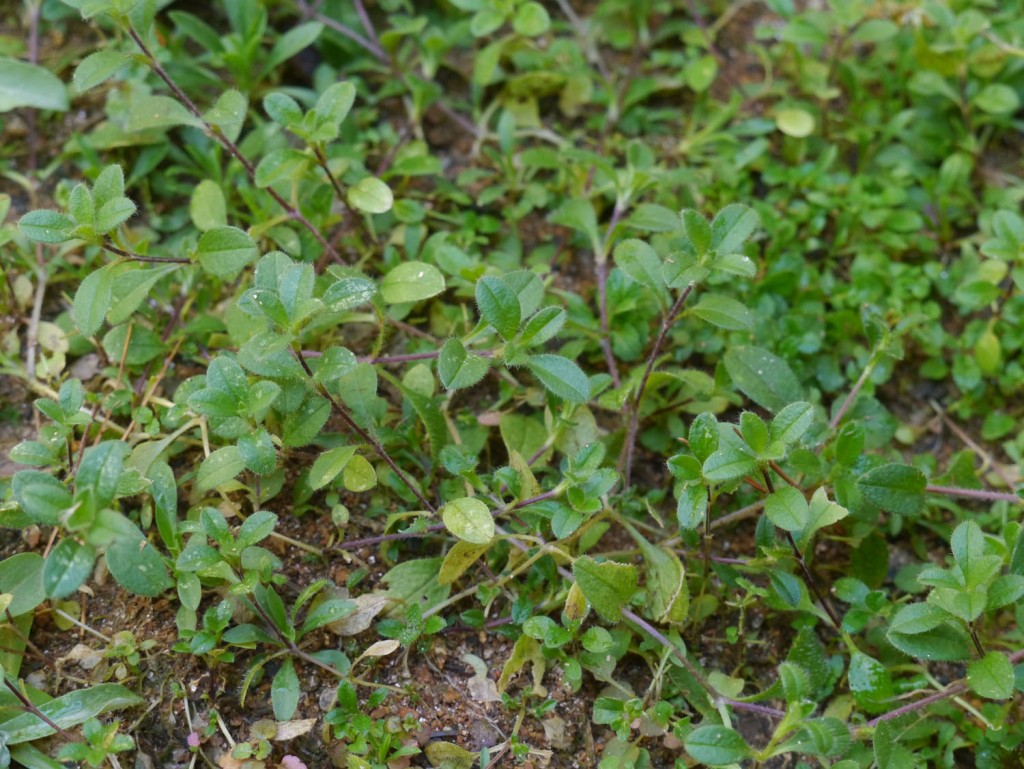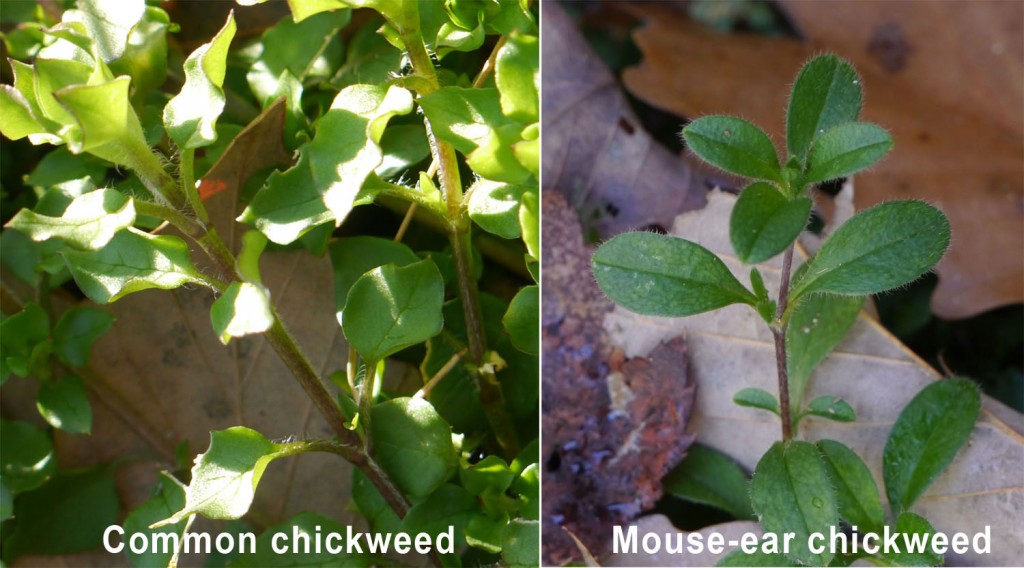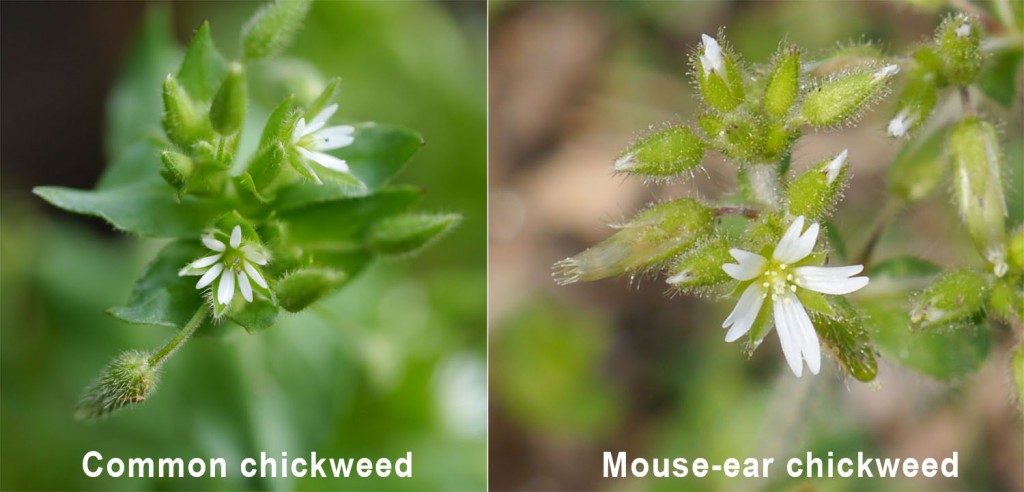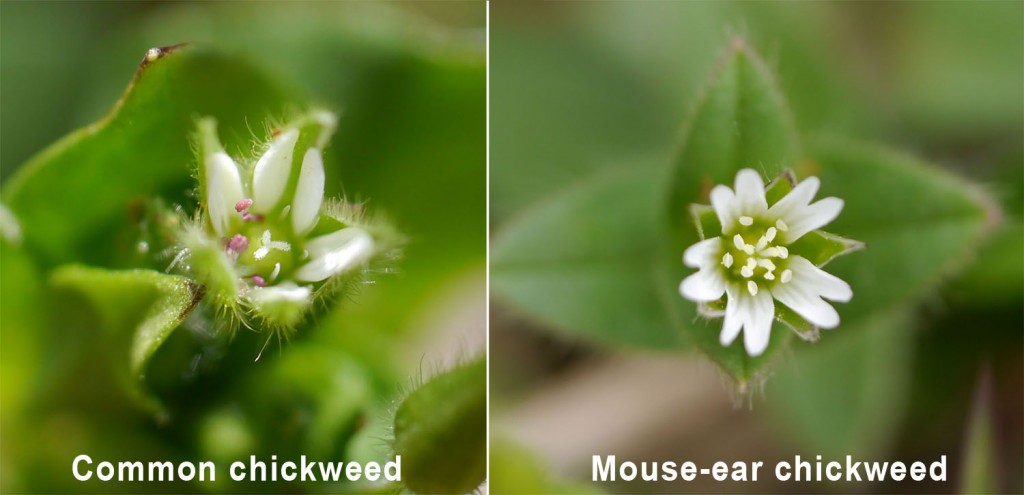This is a patch of Common chickweed (Stellaria media). Next is a patch of Mouse-ear chickweed (Cerastium fontanum).
Similarities abound with these two plants. And there are some distinct differences. Let’s start with how they are alike. Both have leaves arranged oppositely along the stem.
When you pull gently on the stems of each plant, they stretch apart to reveal an inner core.
Both chickweeds grow in the same habitat. Both have the same low-to-the-ground and spreading overall shape.
Now for some differences. The leaves are differently-shaped.
The older leaves of Common chickweed have stems (peduncles) while all the Mouse-ear chickweed leaves are sessile (no stems). The stems of Common chickweed have a line of hairs between each node while the stems of Mouse-ear chickweed are hairy all over.
The flowers have two distinguishing differences. The five petals of Common chickweed are deeply divided — so much so that it looks like ten petals. The five petals of Mouse-ear chickweed are divided — but not so deeply — usually no more than half the length of the overall petal.
The second difference is the number of styles within each flower. For this, you will have to get very close to the flower. A hand lens might even be necessary.
Chickweeds in the Stellaria genus have three styles — as in Common chickweed (Stellaria media). Chickweeds in the Cerastium genus have five styles — as in the Mouse-ear chickweed (Cerastium fontanum).









Pingback: Chickweed harvest | Garden Conversations
Hi Angelyn, I immensely enjoy your website and all the update that I receive via e-mail. I recently stumbled upon your (2012) post about Stellaria Media and Cerastium differences. Brilliant! Such a good explanation and illustrations! If I had you as a science teacher…I would have became a botanist! Thanks for your time and efforts, continue in good health
the best identifying information I have ever found. thank you for all the work that went into this. I now feel confident that I can identify both kinds of chickweed.
I’m living in Queensland Australia, there is a weed which grows here and the locals call it “Summer Chickweed” its obviously not Chickweed but our finches eat it.
It grows rapidly to about a foot in high then it falls over and self layers with roots coming out of the stems. the leaves are light to mid green about 25 mm long and 15 mm wide they are oval but with a point, they also have four veins spreading from the stem of the leaf.
The flowers are about 4mm wide circular with 5 white petals spaced out around the edge of a yellow center .
Anyone have any idea of the plant I’m feeding my birds?
A Walker
Perhaps your plant is “Snow in Summer” which has the scientific name of Cerastium tomentosum. Notice that this genus name (Cerastium) is the same genus as the mouse-ear chickweed featured above. Or your plant be another species of Cerastium.
Also, check out this website filled with resources to help you with identifying your plant. http://www.ala.org.au/faq/species-identification/
Thank you so much for this utterly clear explanation. It is helping me to order the exact seeds I want. I have recently moved to Southern Vermont and oddly enough, at least were I live there isnt chickweed growing everywhere! Ive gotten so used to foraging for it that I’m going to seed my garden with it to get it started. Thanks again.
Hi, Im having a hard time identifying the styles is the pic. I don’t see one having 5 and the other having 3.
If you look closely in the very center of each flower in the final set of images, there are some small white lines. Each small white line is a style — three for Common chickweed (on the left) and five for Mouse-ear chickweed (on the right).